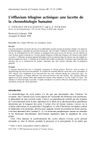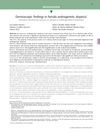Search
for
Sort by
Research
930-960 / 1000+ results
research Mrp4, A New Mitogen-Regulated Protein/Proliferin Gene; Unique in This Gene Family for Its Expression in the Adult Mouse Tail and Ear
A new gene, mrp4, is found in mice and may play a unique role in hair follicle development in tails and ears.

research Follistatin Promotes LIN28B-Mediated Supporting Cell Reprogramming and Hair Cell Regeneration in the Murine Cochlea
Follistatin and LIN28B together improve the ability of inner ear cells in mice to regenerate into hearing cells.
research CircRNA-1926 Promotes Differentiation of Goat SHF Stem Cells into Hair Follicle Lineage by miR-148a/b-3p/CDK19 Axis
circRNA-1926 helps goat stem cells turn into hair follicles by affecting miR-148a/b-3p and CDK19.
research Mice Lacking the Epidermal Retinol Dehydrogenases SDR16C5 and SDR16C6 Display Accelerated Hair Growth and Enlarged Meibomian Glands
Mice without certain skin enzymes have faster hair growth and bigger eye glands.

research Alopecia Areata in a Rhesus Monkey (Macaca Mulatta)
The monkey's hair loss was due to an autoimmune disease, not genetics.
research Discrete Nanoscale Distribution of Hair Lipids Fails to Provide Humidity Resistance
Hair lipids do not protect against humidity.

research Platelet-Rich Plasma as a Therapy for Androgenic Alopecia: A Systematic Review and Meta-Analysis
PRP treatment increases hair density and thickness in androgenetic alopecia by 79%.

research Exploring the Potential of Minoxidil Tretinoin Liposomal-Based Hydrogel for Topical Delivery in the Treatment of Androgenic Alopecia
Minoxidil tretinoin liposomal based hydrogel shows promise for effective treatment of hair loss by delivering both drugs at the same time.
research Comparison of the Effect of Diode Laser Versus Intense Pulsed Light in Axillary Hair Removal
Diode laser removes hair better but is more painful than intense pulsed light.

research Applications and Implications of Heparin and Protamine in Tissue Engineering and Regenerative Medicine
Heparin and protamine are promising in tissue repair and organ regeneration, including skin and hair.

research Recent Updates on Wnt Signaling Modulators: A Patent Review (2014-2020)
New patents show progress in developing drugs targeting the Wnt pathway for diseases like cancer and hair loss.
research Hairless Down-Regulates Expression of Msx2 and Its Related Target Genes in Hair Follicles
Hairless protein reduces Msx2 gene activity, affecting hair follicle development.

research Chi-miR-30b-5p Inhibits Dermal Papilla Cells Proliferation by Targeting CaMKIIδ Gene in Cashmere Goat
A specific microRNA, chi-miR-30b-5p, slows down the growth of hair-related cells by affecting the CaMKIIδ gene in cashmere goats.

research Alopecia Induced by Autologous Fat Injection into the Temporal Area: Case Report and Review of the Literature
Fat injections in the face can cause hair loss.

research Efficacy and Safety of Oral Minoxidil 5 mg Daily During 24-Week Treatment in Male Androgenetic Alopecia
Oral minoxidil improves hair growth in men with hair loss, but caution needed for those with heart issues.

research Cicatricial (Scarring) Alopecia: Clinical Presentations, Etiologies, and Histopathologic Features
Different types of scarring alopecia may be stages of one disease, and accurate diagnosis is crucial to prevent permanent hair loss.

research Actinic Telogen Effluvium: A Facet of Human Chronobiology
Hair loss increases between July and October, possibly due to UV light, and factors like skin type, hair color, and density may affect this. Dandruff can worsen hair loss conditions.
research Topical and Nutricosmetic Products for Healthy Hair and Dermal Anti-Aging Using Dual-Acting Plant-Based Peptides, Hormones, and Cannabinoids
Plant-based products can improve hair and skin health without harmful side effects.

research Early-Stage Bilayer Tissue-Engineered Skin Substitute Formed by Adult Skin Progenitor Cells Produces an Improved Skin Structure In Vivo
Adult skin cell-based early-stage skin substitutes improve wound healing and hair growth in mice.

research Quorum Sensing and Other Collective Regenerative Behaviors in Organ Populations
Organs like hair follicles can renew themselves in complex ways, adapting to different needs and environments.
research Hair Breakage in Patients of African Descent: Role of Dermoscopy
Dermoscopy helps quickly identify hair breakage in people of African descent.

research Dermoscopy Findings in Female Androgenetic Alopecia
Dermoscopy effectively diagnoses and evaluates female hair loss treatment.

research Stem Cells from Human Exfoliated Deciduous Teeth Promote Hair Regeneration in Mice
Baby teeth stem cells can help grow hair in mice.

research Topical Odorant Application of the Specific Olfactory Receptor OR2AT4 Agonist, Sandalore, Improves Telogen Effluvium-Associated Parameters
Sandalore® improves hair growth and quality in people with hair loss.
research Comparative Analysis of Biological Properties of Large-Scale Expanded Adult Neural Crest-Derived Stem Cells Isolated from Human Hair Follicle and Skin Dermis
Skin-derived stem cells grow faster and are easier to obtain than hair follicle stem cells, but both can become various cell types.

research Effects of Food-Derived Collagen Peptides on the Expression of Keratin and Keratin-Associated Protein Genes in Mouse Skin
Eating collagen peptides may help with skin and hair growth.

research Chemoprevention of Doxorubicin-Induced Alopecia in Mice by Dietary Administration of L-Cystine and Vitamin B6
L-cystine and vitamin B6 at high doses prevented hair loss in mice treated with a chemotherapy drug.

research A Non-Invasive Study of Alopecia in Japanese Macaques Macaca Fuscata
About 20% of Japanese macaques had head alopecia, and stress and environment might cause hair loss.

research Acne and Hirsutism in Teenagers
Acne and increased body hair in teenage girls are normal but severe cases may need hormone evaluation and treatment can prevent diabetes linked to PCO.